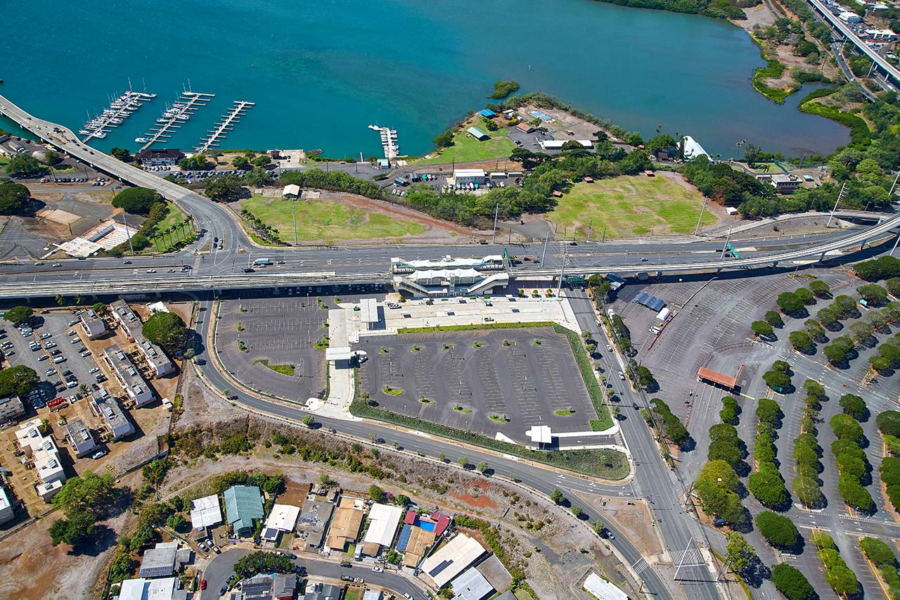Long-awaited Honolulu rail likely to disappoint
(Photo Credit: HART) Aloha Stadium (Halawa) station is one of the nine stations expected to open this July. The station is located at the intersection of Salt Lake Boulevard and Kamehameha Highway.
May 2, 2023
During his State of the City address on March 14, 2023, Honolulu Mayor Rick Blangiardi announced that a 10.8-mile (17.4 km) section of the rail from East Kapolei to Aloha Stadium would open in July. In 2012, when the City and County of Honolulu and the Federal Transit Administration signed a Full Funding Grant Agreement for the project, the rail was expected to cost $5.12 billion and the entire 20-mile (32 km) system was expected to be fully operational by 2020. The rail is now expected to cost around $12.45 billion and not be fully operational until 2031.
In 2006, the City and County of Honolulu released the Honolulu High-Capacity Transit Corridor Project Alternatives Analysis Report which considered several alternative solutions to provide better mobility for people traveling along the congested south shore of Oahu. The report predicted that there would be about 94,970 boardings of the rail daily and that there would be about 11% less vehicle hours of delay (a measure of congestion) in 2030 than in 2005 if the rail was built. The report concluded: “While the Fixed Guideway Alternative would have the highest cost, it is also the only alternative that would provide a substantial transportation benefit, measured both by the benefit to transit users and in the reduction in congestion compared to the No Build Alternative.” However, because of poor design decisions and mismanagement at the Honolulu Authority for Rapid Transportation (HART) and the car-centric design of Honolulu, it is unlikely that the rail will meet this potential.
Perhaps the largest mistake made by HART was attempting to begin construction before completing all of the necessary planning work. For example, in 2009, HART awarded the first contract to build the first section of the rail along the Farrington Highway to Kiewit Pacific Co. However, it did so before acquiring all of the necessary federal approvals, and, according to the state auditor: “Just four months after that contract was executed on November 11, 2009, delays in required federal approvals resulted in Kiewit starting to accrue delay costs that ultimately would be passed on to the City.” Then, in 2011, HART was sued for starting construction before completing an archaeological survey of the whole line. This led to work stopping in 2012 for 13 months and delay costs of $40 million.
In 2019, the state auditor noted a pattern of HART underreporting the costs and the expected completion of the rail to the public. The audit concluded: “Over-promise, under-deliver. It has been the hallmark of the Honolulu Rail Transit Project’s near-decade long, stop-and-go journey.”
Other problems have arisen from HART’s desire to reinvent the wheel— often quite literally— problems have resulted from HART’s plans to use non-standard wheels that didn’t fit the track. It is not clear how much it will cost to replace all of the wheels. Similar problems have emerged from HART’s decision to use “flange-bearing” frogs rather than the more standard “tread-bearing” frogs (frogs are the devices that allow trains to switch from one track to another). HART apparently refused suggestions to replace its wheels and frogs with the more standardly used ones, a move that could lead to higher maintenance costs.
Additionally, Honolulu’s car-centricity and poor pedestrian environment, especially in the primarily suburban areas along the first section of the rail, is questionably suited for rapid transit. Honolulu would be wise to consider the mantra that every transit trip begins and ends with a walking trip, especially because only three of the nine stations in the first section of the rail currently have parking facilities, and none of the stations in other segments of the rail will have parking facilities.
Consider the walk from Radford to the Aloha Stadium station. Although the walk is only about 20 minutes, it is not necessarily pleasant due to narrow sidewalks, a lack of shade, and cars going much faster than 25 mph on Salt Lake Boulevard. Likewise, Pearlridge station is about a 10-minute walk from the Pearlridge Center, a walk that involves an unsignalized crosswalk across four lanes of traffic and navigating the center’s busy parking lot. Similarly, other stations are located between highway ramps (Pearl Highlands), in the middle of an industrial area (Waipahu Transit Center), or surrounded by farmland (Honouliuli). In other words, they are not easily accessible to the destinations that they are meant to serve. Worryingly, several mainland cities which have built light rail have not seen more people riding public transit, largely because these light rail systems fail to connect destinations people want to go and integrate with appealing pedestrian environments.
If the Honolulu rail is to meet its potential, then it is necessary that there is better transparency and oversight at HART and that Honolulu becomes a city designed for people rather than cars, until then, it is likely to continue to over-promise and under-deliver.


